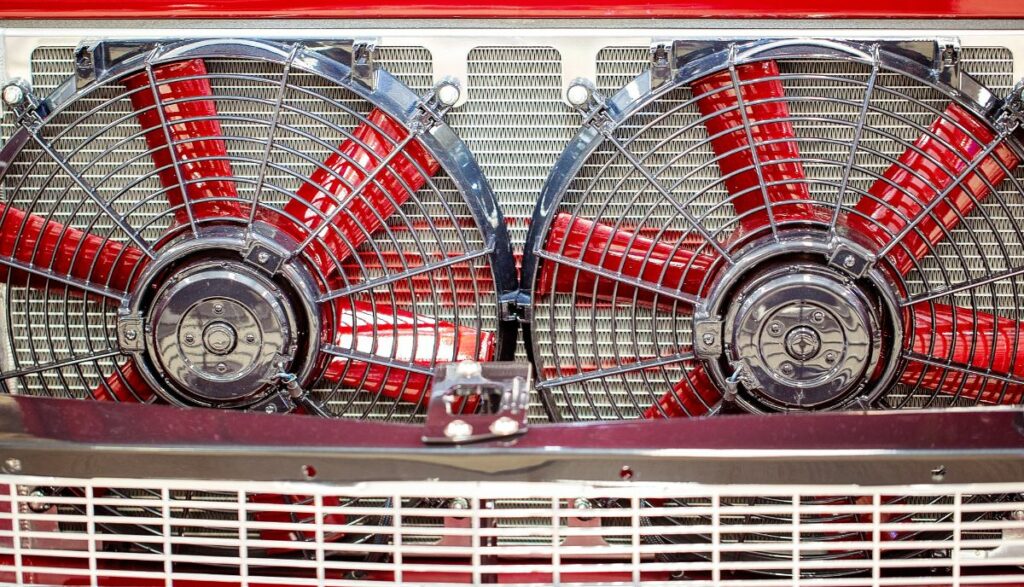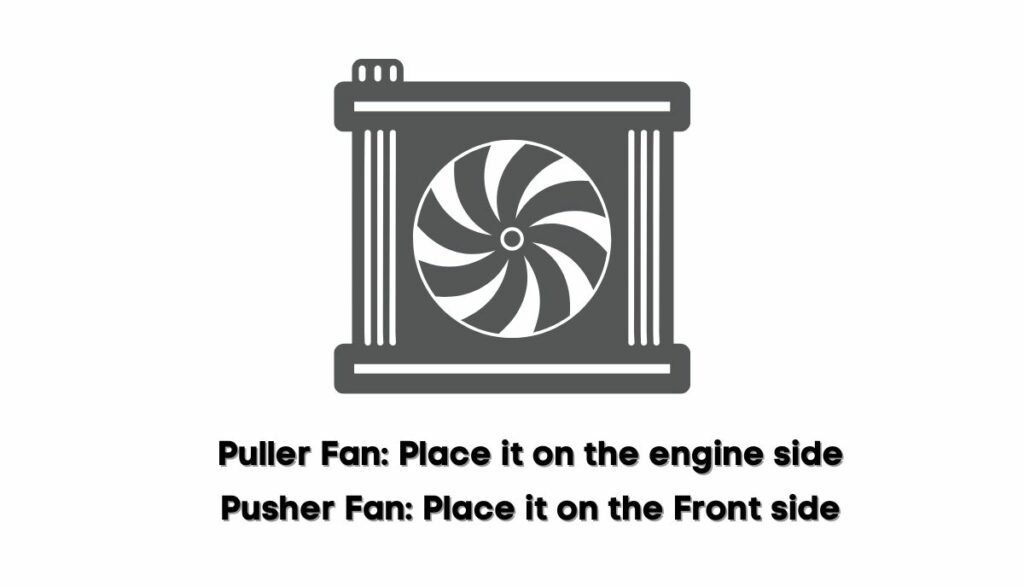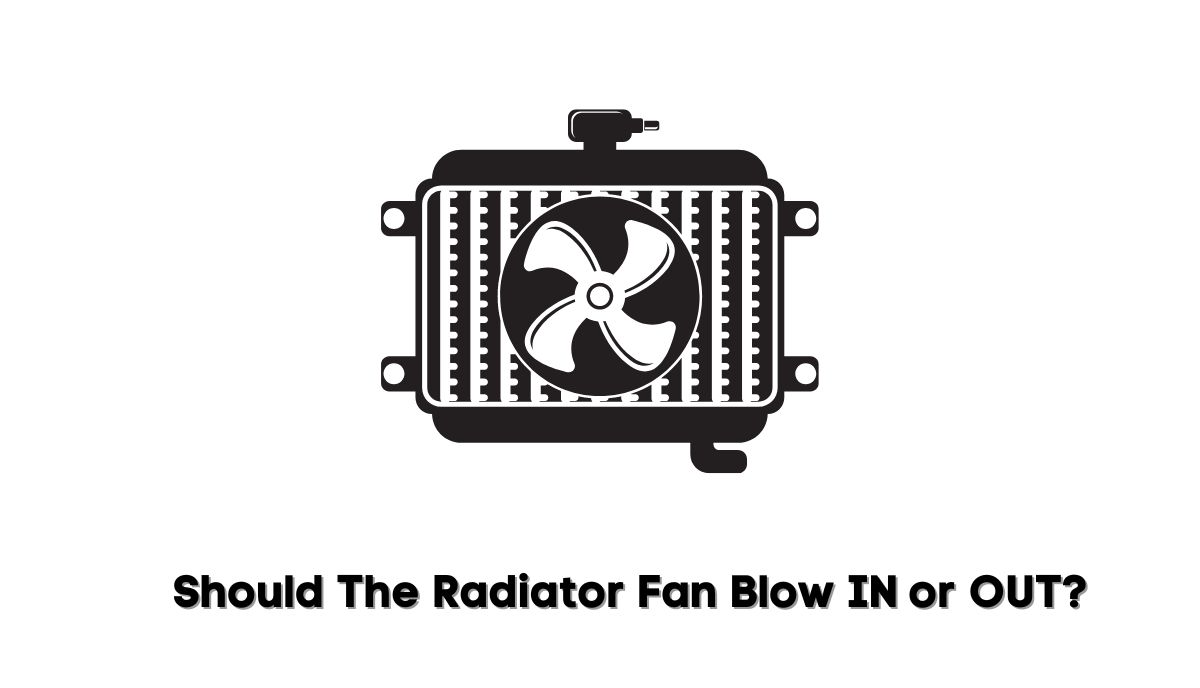The radiator fan serves a dual purpose, drawing in outside air to cool the radiator while the vehicle is in motion. Additionally, at low speeds or when the engine is idling, the fan enhances air circulation under the hood.
If you’re looking to replace a radiator fan, your selection will depend on the following factors:
1). Mechanical VS Electric Cooling Fan

Cooling fans are mechanical or electrical. Mechanical fans appear in older vehicles. They rely on pulleys and belts connected to the crankshaft. Mechanical fans only spin at low or idling engine speeds.
Electric fans use electric sensors and controllers. They only spin when the temperature exceeds a specific threshold. This prevents the fan from running unless the engine temperature is high. Mechanical fans occupy more space. Additionally, you can’t trust them to move sufficient air while the engine idles.
Electric fans are easier to install because of their compact design. They are also easier to control.
2). Push VS Pull
This consideration is just as important as the fan type, and it provides clarification to laypeople who don’t know whether a fan should blow in or out. Some fans are pullers. They suck air into the radiators. Other fans are pushers. They push air into the radiator.
But if both options are correct, why do some people complain that their radiator fan is blowing in the wrong direction? Because the fan’s ability to pull or push air depends on its location.
A fan in front of the radiator should push air from the environment into the radiator. A fan behind the radiator will pull air through the radiator. A fan behind the radiator shouldn’t push air. A fan in front of the radiator shouldn’t pull air.
Fans with the wrong orientation (and location) will cause the engine to overheat even though they clearly work because they’ve failed to improve the radiator’s airflow. Some fans can only perform one function. They will either push or pull air, and placing the components in the wrong location will compromise their ability to cool the engine. Others provide both options. You can change the pull function into a push function.
3). Blade Type
Are the fan blades curved or straight? Davies Craig performed a test and concluded that curved blades reduce the fan’s noise and performance (they stall at a lower static pressure). You get less noise because the fan is moving less air. Straight blades make more sense in engines with a penchant for overheating.
What Are The Two Possible Orientations Of The Radiator Fan – Blowing Air Into The Radiator Or Out Of It?

Technically, your car can use either option, but only if you install the fan in the correct location:
- Because a puller fan sucks air through the radiator, you should place it on the engine side of the radiator.
- Pusher fans blow air through the radiator. Therefore, you can mount them on the front side.
- Puller fans are more efficient, which explains their popularity. They move more air than their pusher counterparts.
- Unfortunately, puller fans are not an option for some people because the space between the radiator and engine is too small to accommodate a pull fan.
- You can install a pusher fan in an older vehicle that already possesses a mechanical fan. The pusher fan will boost airflow.
- Some cars have a dual-fan setup because the radiator is enormous. A dual-fan configuration requires compact fans. Otherwise, they won’t fit.
- The CFM should influence your fan selection. Those letters stand for ‘Cubic Feet Per Minute.’ They reveal the volume of air a fan will move. A higher CFM points to a fan that moves more air than one with a lower CFM. It will also make more noise.
- When you install smaller fans in a dual-fan system, their CFM should match the engine’s needs. Otherwise, you’re better off installing one large fan.
- The fan speed won’t influence the orientation. However, it is worth noting that some fans have two speeds. They will switch between high and low speeds depending on the temperature.
Advantages And Disadvantages Of Puller vs. Pusher Fan
Puller fans are more prevalent because of their performance. However, many cars on the road today possess pusher fans. You can’t rule them out as a viable option.
Puller Fans
As their name suggests, puller fans suck air through the radiator as opposed to blowing it. A puller fan won’t work if you mount it in front.
Pros
- The only significant advantage puller fans have over pusher models is their efficiency.
- Puller fans can cool engines that generate excess heat because they move more air.
- You can install a shroud to improve efficiency.
- Superior airflow dispersion to the radiator face.
Cons
- Some cars don’t have room between the engine and the radiator. They can’t accommodate the puller fan.
Pusher Fans
Pusher fans blow the air through a radiator instead of pulling it. You can find pusher fans on the market that match a puller fan’s efficiency.
Pros
- Chevy Hardcore associates pusher fans with a higher mass flow rate.
- A pusher fan acts on cooler and dense air, at least in comparison to the air the puller fan encounters in the engine bay.
Cons
- Puller fans sit in front of the radiator. In the process, they restrict the radiator’s airflow.
- You can’t use a shroud.
You can install a pusher and a puller fan on the same radiator. The practice is not ideal. But it can work.
Explanation Of Having The Fan Blow Air Into The Radiator. How It Helps Draw Ambient Air Through The Radiator Fins For Cooling?
Contractors mount the pusher fan in front of the radiator. Motor Trend expects to find this fan type in vehicles with significant modifications. The device cools the engine by forcing cold air through the radiator.
Pushers are less efficient than pullers because they restrict the volume of air passing through the radiator when you drive at high speeds. Usually, the car relies on the air that flows naturally through the grill to lower the coolant temperature. The fan doesn’t spin during such instances.
Therefore, a fan in front of the radiator that restricts airflow is inconvenient. You can mount both fan types if the existing fan is too weak or doesn’t permit the installation of a shroud due to space limitations. Modifications will eliminate the challenge of limited space. You can move the engine to make room for the correct fan type and shroud.
Explanation Of Having The Fan Blow Air Out Of The Radiator. How It Aids In Pushing Heated Air Away From The Engine?
Fans are designed to do what the car does naturally. When you drive at a high speed, air will flow through the grill’s openings and slats. Fans only matter when you slow down. Whether you use a pusher or a puller, the air will do the same thing.
It will flow into the engine bay. Some drivers question whether it is more efficient to suck cold air into the engine bay or blow warm air out. However, that question is flawed. First, a radiator fan does not blow hot air out of the engine bay. Instead, it forces cold air from the atmosphere through the radiator.
Secondly, by pulling cold air in, the fan inadvertently displaces the hot air, ejecting it. Ultimately, fans don’t cool the engine, at least not directly. You can’t lower an engine’s temperature by cranking a fan to its highest speed.
The coolant is designed to pick up heat as it flows through the engine. The fan cools the coolant, not the engine. Once the coolant’s temperature plummets, it will repeat its journey through the engine. You can achieve this objective with fans that blow in or out of the radiator.
The Importance Of Proper Fan Orientation For Cooling System Effectiveness
The orientation influences the fan’s ability to cool the radiator and its coolant. You can’t trust a pusher fan behind the radiator to move sufficient air. The same applies to a puller fan on the front side.
For satisfactory air flow, you must position the pusher in front and the puller behind. Some drivers expect the fan to expel hot air. However, hot air blowing out of the front grill should concern you. This phenomenon can occur for one or more of the following reasons:
- If a repair shop replaced the fan or its wiring recently, they probably reversed the polarity. You need an expert to check the fan’s wiring.
- If you suspect an electronic glitch, consider rebooting the ECM.
- You might have replaced a push fan with a puller fan or vice versa.
- Someone mounted a pusher fan behind the radiator or a puller fan in front.
- The fan has the wrong blade orientation. As such, the device is blowing air in the wrong direction.
- You reversed the fan’s orientation. Some fans offer both push and pull functions. But you must adjust the fan to make it pull or push before installation. It can’t switch automatically between the two. This CARiD video shows users how to turn a Flex-A-Lite puller fan into a pusher. Some people make this adjustment unknowingly.

